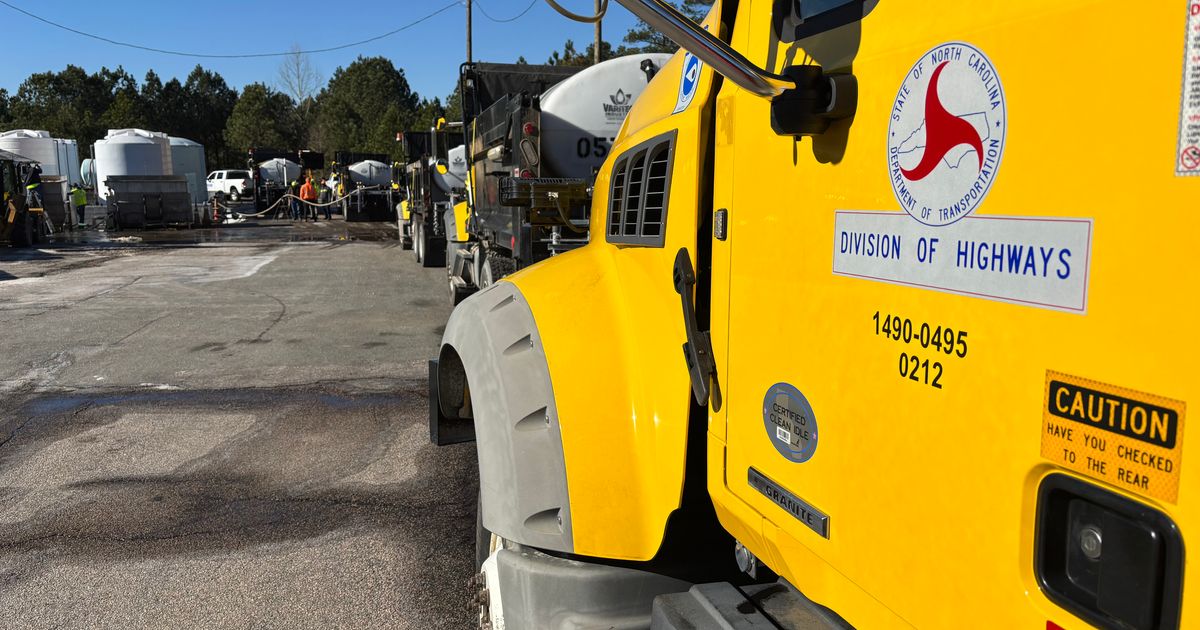Raleigh and state crews have already hit North Carolina’s roads, laying brine to prepare for the winter storm headed this way.
Drone 5 flew overhead Thursday as brine trucks were filled at the city of Raleigh’s transportation field service office. The brine comes from vats filled with 50,000 gallons of salty solution.
The trucks feature 1,600 gallon tanks to hold brine. Raleigh crews said it takes about 20 minutes to load up the trucks, and the brine will be used within an hour. The city is responsible for about 840 miles of road, and Raleigh crews said the plan is to brine every single mile.
Brining the roads lowers the freezing temperature of the pavement. The process makes roads easier to plow when the time comes.
Because of the lack of snow in recent years, much of the brine used Thursday dates back to 2021. Whether it was made four years ago or yesterday, it’ll work, the city said.
“I’ve seen times where you could put down brine,” said Jason Holmes, manager of Raleigh’s transportation department. “It starts as a snowfall, and it may buy you a few hours of time before it starts really sticking to the pavement, because that’s what you’re trying to do is eliminate that adhesion to the pavement because it’s easier to push off.”
Holmes said the trucks release about 40 gallons of salt brine per mile.
The solution is just over 23% salt. For comparison, the ocean is about 3% to 5% percent salt, so brine is about 5% times saltier than the sea.
On Wednesday, the North Carolina Department of Transportation (NCDOT) was already out preparing for the winter
weather expected on Friday night.
Crews spent hours mixing up a salt brine.
NCDOT trucks then hit the road, layering that mixture over nearly
15,000 lane miles across our area to try and make the roads safer for drivers
this weekend.
The 5,000-gallon tanks get filled with a mixture of salt
and water. The NCDOT feels confident the roads will be ready to go at the end of the
week.
“We can do snow and ice as good as anybody,” said
Doug McNeal with the NCDOT. “The trick of it is, is a lot of our folks
just don’t have the experience that you do when you grow up in it or when
you’re experiencing it every day. We’re looking at 1,000 days since our last
snow event. In that time, we have a lot of new drivers to the area and young
drivers, and this has been their first time in it. So everybody just needs to
be patient.”
We’re told 14,000 tons of salt is available
to crews.
It may sound like a broken record, but NCDOT is reminding
everyone to slow down. This is the first time some drivers in our area are hitting
the streets with conditions like this.
And if you see one of these trucks, give them space. It’s
advised you give about 200 feet, if you can, which is about 10 to 12 car
lengths.
Cary prepares for first major snow in 3 years with 24/7 Brine Truck operations
Brine trucks are covering over 700 miles of roadway, creating a protective layer to prevent ice from sticking to the asphalt.
“We brine at 40 gallons per mile. With that, we’ve got a 24/7 operation,” Cary’s Public Works Director, Matt Flynn, said.
Cary’s brine trucks are hitting main roads, neighborhoods, and even trash routes, while state trucks are focusing on highways and interstates.
Preparations began 72 hours ahead of the anticipated snow, but cold temperatures are narrowing the window for applying brine effectively.
Beyond the roads, Wake EMS is also ramping up efforts, increasing staff and equipping vehicles with ice melt.
“We’re preparing for delays and advising staff to dress warmly and be ready for black ice,” said Victoria Huffman, Wake County EMS Commander of Community Outreach.
This will be the Triangle’s first major winter event in nearly three years, and agencies are feeling the pressure.
Flynn said, “We take this very personally. We’ll be here 24/7 until the event ends.”
Officials urge residents to stay off the roads this weekend—for their safety and to give crews the space they need to do their jobs.










